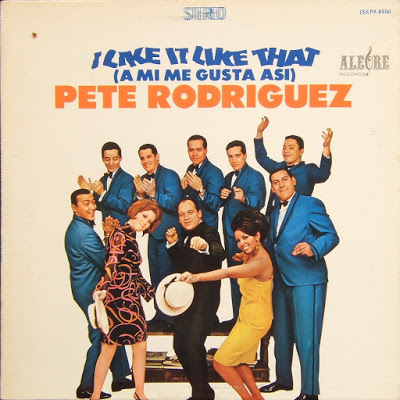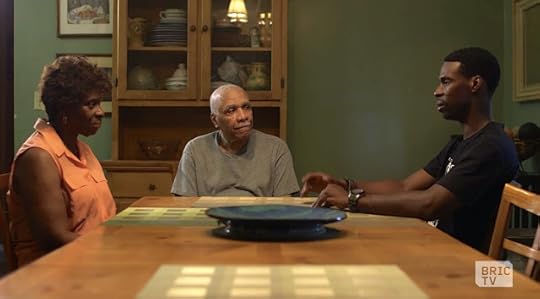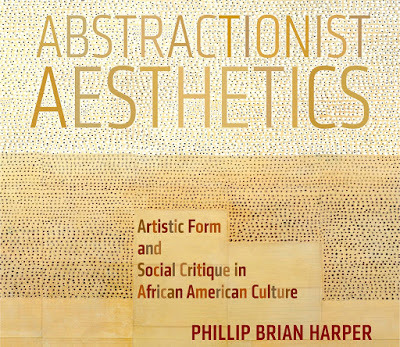Mark Anthony Neal's Blog, page 648
January 29, 2016
#TheSpin: 'New' American Industry--The Marijuana Industrial Complex
 On this episode of
#TheSpin
, Christina Greer + Sofia Quintero + Bhakti Shringapure join host Esther Armah in a conversation about the Marijuana Industrial Complex, the re-emergence of Sarah Palin and balancing racism in academia.
On this episode of
#TheSpin
, Christina Greer + Sofia Quintero + Bhakti Shringapure join host Esther Armah in a conversation about the Marijuana Industrial Complex, the re-emergence of Sarah Palin and balancing racism in academia.
Published on January 29, 2016 12:40
January 28, 2016
Latin Soul Classics: Pete Rodriguez--"I Like It Like That"
 Pete Rodriguez's 1967 classic "I Like It Like That," a precursor to the sounds that would inform the birth of Hip-Hop.
Pete Rodriguez's 1967 classic "I Like It Like That," a precursor to the sounds that would inform the birth of Hip-Hop.
Published on January 28, 2016 06:03
January 27, 2016
BK Stories: Families and Gun Violence in Brooklyn, Part 2
 'In part two of a series on Brooklyn gun violence, Marlon Peterson talks to his parents about their experience when he was given his 12 year prison sentence. Underlying issues that may contribute to the presence of gun violence within communities of color in Brooklyn are discussed as well as a look into a meeting among the top leaders of anti-gun violence organizations in Brooklyn where they talk on Child Safe Zones initiatives.' -- +BRIC TV
'In part two of a series on Brooklyn gun violence, Marlon Peterson talks to his parents about their experience when he was given his 12 year prison sentence. Underlying issues that may contribute to the presence of gun violence within communities of color in Brooklyn are discussed as well as a look into a meeting among the top leaders of anti-gun violence organizations in Brooklyn where they talk on Child Safe Zones initiatives.' -- +BRIC TV
Published on January 27, 2016 21:05
Two Little Known Police Shootings in Chicago Come to Light
 'Two little known Police Shootings in Chicago have come to light and the officer was not charged in either case. The parents of the victims sat down with +Al Jazeera America News's Andy Roesgen to discuss the cases.'
'Two little known Police Shootings in Chicago have come to light and the officer was not charged in either case. The parents of the victims sat down with +Al Jazeera America News's Andy Roesgen to discuss the cases.'
Published on January 27, 2016 21:00
Black Brilliance: Cam Newton and the Future of the NFL by Lawrence Ware
 Black Brilliance: Cam Newton and the Future of the NFLby Lawrence Ware | @Law_Ware | NewBlackMan (in Exile)
Black Brilliance: Cam Newton and the Future of the NFLby Lawrence Ware | @Law_Ware | NewBlackMan (in Exile)If you’re a black athlete, White Americans will cheer for you; they will attend your games; they will even buy your jersey—just make sure you display endless amounts of humility, meekness, and gratitude. Most white folks want entertainment, but they don’t want the help acting too uppity. That’s why Cam Newton is the kind of black athlete white folks tend to hate.
Like Jack Johnson and early Mike Vick, Newton refuses to acquiesce to the expectations of white folks. He has young, white middle class kids doing the Dab, and he organically uses metaphors centered in the black experience when talking to the media. (When was the last time you heard a quarterback talk about collard greens?) Cam also plays a position that, in a sport full of black athletes, remains overwhelmingly white.
According to Pro Football Weekly, while black athletes represent two-thirds of the players in the NFL, only 20 percent are quarterbacks, and of those, only 12 percent started games. Further, a study by economist Brian Volz published in the Journal of Sports Economics shows that if a there is a sub-par performance, “black starting quarterbacks are 1.98 to 2.46 times more likely to be benched the next week" than white quarterbacks with a similar skill set. "This implies that black quarterbacks may face some level of discrimination in the NFL,” stated Volz.
Enter Cam Newton.
Newton was a divisive figure before he even entered the NFL. From allegations that money influenced his decision to attend Auburn to those contending that he should give back the Heisman trophy, Cam, for years, has been a lightening rod for controversy.
When the Carolina Panthers drafted him as the first overall pick, some called him the “worst NFL draft pick ever.” That headline is laughable today, but it illustrates the kind of vitriol Newton attracts. Even as he led the Panthers to the Super Bowl this season, he faced heavy criticism. He was criticized for his dancing; he was criticized for his smile; many despised the towel over his head; some said he set a bad example by being an unwed father; and he was called ‘Classless Cam’ for tearing down a Seattle Seahawks 12th man flag. There is even a #BanTheCam Change.org petition stating that:
Cam Newton is one of the most unprofessional, unsportsmanlike individual on the face of the planet. So I say for the 2016-2017 when the Panthers come to play in Seattle he should be banned from entering the stadium. This should teach him to put his arrogance in check!
I think part of the reason why Newton draws the ire of so many is that he embraces black culture in a way that is subversively unapologetic. He does everything he is supposed to do: he answers questions at the press conferences; he gives credit to his teammates; he does charity work in the community, but he does it all his way. That is, he does not try to hide the fact that he was reared in a black, working class milieu.
Newton’s blackness is unavoidable. He wears gators and uniquely patterned suits; he doesn’t engage in the code switching often used by other black professionals. If the press ask him a question, he answers them in a black southern vernacular that doesn’t try to hide Africanisms. As Bomani Jones said, he is the embodiment of everything black men are told you cannot be and achieve success. He is uninterested in being ‘respectable.’ He is not trying to prove he belongs. Cam’s authenticity is confrontational in how it forces white supremacy to come to terms with his athletic brilliance…and brilliant he is.
Before now, black quarterbacks were thought of as run first, pass second threats. The notion of a genuine dual threat—a quarterback that is just as dangerous as a passer as he is a runner—was often discussed but rarely believed. There were questions about a black quarterback’s ability to stay in the pocket, drop back, and throw a pass. Further, there were racist assumptions about a black quarterback’s intellectual ability to play the position.
Cam represents the future of the NFL because he shatters all those stereotypes. He is an incredibly accurate passer that can beat you with his legs because of his ability to read the defense. Cam Newton will be remembered as a revolutionary figure in the history of the NFL. Both because of his cultural impact and because of how he is changing the quarterback position.
I’ll be cheering for the Carolina Panthers during the Super Bowl. Not because I have a regional reason to do so, but because I want to witness black brilliance on display. Dab on them folk, Cam.
+++
Lawrence Ware is an Oklahoma State University Division of Institutional Diversity Fellow. He teaches in OSU's philosophy department and is the Diversity Coordinator for its Ethics Center. A frequent contributor to the publication The Democratic Left and contributing editor of the progressive publication RS: The Religious Left, he has also been a commentator on race and politics for the Huffington Post Live, NPR's Talk of the Nation, and PRI’s Flashpoint. Follow him on Twitter: @law_ware
Published on January 27, 2016 20:34
Chamber Soul: The Music Of Shana Tucker
 'When Shana Tucker is singing and playing her music, it’s a heady blend. Tucker calls her music “chamber soul.” It’s jazz, R&B, soul and more– and more than the sum of its parts. Her music is featured on her album, Shine. Shana is also in her fourth year as a singer and cellist in Cirque du Soleil’s “KA” at the MGM Grand hotel-casino.' -- KNPR
'When Shana Tucker is singing and playing her music, it’s a heady blend. Tucker calls her music “chamber soul.” It’s jazz, R&B, soul and more– and more than the sum of its parts. Her music is featured on her album, Shine. Shana is also in her fourth year as a singer and cellist in Cirque du Soleil’s “KA” at the MGM Grand hotel-casino.' -- KNPR
Published on January 27, 2016 19:44
Beyond Real(ism)--Review of Abstractionist Aesthetics: Artistic Form & Social Critique in African American Culture
 Beyond Real(ism): Review of Abstractionist Aesthetics: Artistic Form and Social Critique in African American Culture by Phillip Brian Harper Reviewed by Sasha Panaram | @SashaPanaram | NewBlackMan (in Exile)
Beyond Real(ism): Review of Abstractionist Aesthetics: Artistic Form and Social Critique in African American Culture by Phillip Brian Harper Reviewed by Sasha Panaram | @SashaPanaram | NewBlackMan (in Exile)During the 1950s and 1960s, after World War II, the United States found themselves enmeshed in an extended conflict with the Soviet Union in what became known as the Cold War. As tensions between the two groups increased, the United States employed a variety of tactics to solidify their position as a global superpower. It was at this time that the CIA covertly put their money behind a most unexpected “weapon” to promote U.S. creativity: Abstract Expressionism. For more than 20 years, the CIA helped foster American Abstract Expressionist artwork – like that of Jackson Pollack and Mark Rothko – to provide evidence of U.S. intellectual innovation, cultural capital, and artistic freedom. The Socialist Realist art and propaganda of the Soviet Union could hardly compete with the new wave art taking shape in the U.S.
While Phillip Brian Harper, the author of Abstractionist Aesthetics: Artistic Form and Social Critique in African American Culture (New York University Press, 2015; 256), doesn’t refer to the CIA sponsored support of Abstract Expressionism directly, it is difficult not to think of this moment and what it meant for U.S. cultural production in light of Harper’s own work in his text to reclaim an aesthetic mode that privileges abstractionist` methods over realism in African American culture. As Harper explains in his Introduction, an “…abstractionist aesthetics crucially recognizes that any artwork whatsoever is definitionally abstract in relation to the world in which it emerges, regardless of whether or not it features the nonreferentiality typically understood to constitute aesthetic abstraction per se” (2). Harper maintains that abstractionist art calls attention to a constructed artificiality that prompts those who encounter it to not only speculate about the “naturalness” of the artwork itself, but also the social world to which it gestures (2).
Written in a self-consciously essayist form, Harper’s theoretical text achieves an unparalleled fluidity whereby he rigorously assess how different art forms – visual culture, music, and literature – engage with abstractionist aesthetics. The question that undergirds his entire study is: “how can a work clearly enough ground itself in the real-world racial order to register as black while at the same time clearly enough disassociating itself from lived reality as to register as productively abstractionist” (9)? As Harper highlights the limitations particular art forms face while engaging with abstractionism, he reveals that nonconventional literary works – like experimental poetry or prose – that productively defamiliarize or denounce narrative realism are oftentimes sidelined in African American literary canons (12). In a move similar to Kenneth W. Warren in What Was African American Literature?, Harper pushes for a more expansive definition of African American literature while also advocating for a different aesthetic mode that he firmly believes will give way to new forms of critical productivity.
Chapter One, “Black Personhood in the Maw of Abstraction”, considers how preoccupations in visual art over proper or “proper realist” black representation thwarts productive engagements with abstractionist art (9). By examining criticisms launched at Kara Walker’s famed silhouette cutouts and performances directed by Vanessa Beecroft, Harper emphasizes the strained relationship between African American culture and abstractionism that manifests most clearly in repeated concerns about appropriate racial portrayal.
Abstraction, which Harper acknowledges has historically posed problems for black people insofar as it rendered them inhuman and excluded them from national conceptions of personhood, is an art form understandably viewed with apprehension and even resistance in African American circles. Consequently, there is a tendency to align or assert the realist features in even the most blatantly abstractionist works as a measure of self-preservation. However, Harper posits that this inclination to problematize that which compromises the real or tends toward the fantastic – even when identity politics are at stake – denies abstractionist art the elements that allow for its very existence.
While Harper shows through his own reading of Walker and meditations on Lorna Simpson and Ellen Gallagher’s artwork how contemporary art can achieve abstractionist effects, he is wary of this medium particularly because it is subject, as he says, to too many uncontrollable elements including “the predilections of the individual viewer” (63). Visual cultures failure to fully engage abstractionist aesthetics compels Harper to turn to another art form that might take up this challenge more successfully: music.
Taking us through the rhythms and rhymes of everyone from Billie Holiday to Louis Armstrong to Joseph “King” Oliver to Cecil Taylor and more, Harper reminds us that to really listen to black music we must first learn how to read it; how to trace complex genealogies that sway, split, sample, and shake up ever-expansive musical archives. As Harper interrogates how black music became the quintessence of black culture or “the blackest of all the arts” in Chapter Two, “Historical Cadence and the Nitty-Gritty Effect”, he turns to the work of Ralph Ellison and Amiri Baraka to unearth how jazz manifests in and inspires black literature (114). The more he contemplates the relationship between music and narrative, the more Harper realizes that black music isn’t always as abstract as it initially appears. The more we try to determine the abstractionist qualities in black music, the more we rely on narrative to explain the subjectivity that registers to our ears as black.
Chapter Three then fittingly considers how narrative functions as the optimal site where an abstractionist aesthetics may flourish. Entitled “Telling It Slant”, Chapter Three engages with print prose – both conventional and nonconventional – to see how writers including Gloria Naylor, Ntozake Shange, Alice Walker, and others subvert literary realism. Ultimately Harper turns to experimental literature like that of Nathaniel Mackey and Claudia Rankine to show that “the real itself should be vigorously countered, in the interest of a future that is better than the present” (160).
When Harper expands what we understand as African American literature by embracing innovative forms of storytelling that actively subvert that classified as “real,” he asserts that his critical work does more than alter reading practices, but fundamentally change how we operate in the world on a day-to-day basis; how we conceive of possible futures.
“The Literary Advantage”, which serves as the book’s Coda, both reinforces how experimental prose and poetry can achieve the abstractionist aesthetics Harper chases after and reminds readers by way of analyzing the film, Precious, that movies, too, can function as useful sites of abstraction.
As I finished Abstractionist Aesthetics, I began to think about what its intended implications might look like if I took Harper’s call to vigorously counter the real with the utmost seriousness. My mind didn’t turn to literature initially but to the very real events that marked the 2015 calendar year: Sandra Bland’s death in prison, the non-indictment of the officers who killed Tamir Rice, the bullets shot in the historic AME church in Charleston, South Carolina, the last breaths that marked the final moments of Tanisha Anderson’s life in Cleveland, Ohio, and the young black girl assaulted in a classroom at Spring Valley High School in Columbia, South Carolina.
As I learned about each of these attacks on black life, I found myself completing the same task albeit with a different object every time: reading. The texts I encountered did not necessarily address death explicitly nor did they always deal with the realism Harper actively subverts yet they were mediated by the instances of loss that surrounded me. While these “real” events are not discussed in Harper’s book they do intimately concern his project.
Often in moments of persistent black death, it seems near impossible to think about futurity when life is so abruptly surveilled and destroyed. But if we embrace Harper’s abstractionist aesthetics, while we cannot (nor should not) lose sight of anti-black violence, we can begin to think beyond the scope of what is possible; we can begin to read (and write) new worlds that reflect the futures we hope to one day inhabit. We can begin to live again.
+++
Sasha Panaram is Ph.D. student in English at Duke University. A Georgetown University alumna, her scholarly interests are in black diasporic literature, black feminisms, and visual cultures.
Published on January 27, 2016 06:00
Sonics + Visuals: Santigold--"Chasing Shadows"
Published on January 27, 2016 05:14
January 26, 2016
#TheMovement: Millionaire or Felon? When Smoking Weed In America Your Zip Code Decides
 'Meet the incredible Wanda James, the only black woman who owns a legal weed dispensary in Colorado. And after you meet her, meet her brother, Rick, who was thrown in jail for years for possession of marijuana.' --
.Mic
'Meet the incredible Wanda James, the only black woman who owns a legal weed dispensary in Colorado. And after you meet her, meet her brother, Rick, who was thrown in jail for years for possession of marijuana.' --
.Mic
Published on January 26, 2016 18:18
5 Questions: DeRay Mckesson Discusses Racism + White Privilege + Democratic Candidates
 'DeRay Mckesson sat down with Dena in a surprise visit to +AJ+ to talk about some important issues.'
'DeRay Mckesson sat down with Dena in a surprise visit to +AJ+ to talk about some important issues.'
Published on January 26, 2016 18:05
Mark Anthony Neal's Blog
- Mark Anthony Neal's profile
- 30 followers
Mark Anthony Neal isn't a Goodreads Author
(yet),
but they
do have a blog,
so here are some recent posts imported from
their feed.




